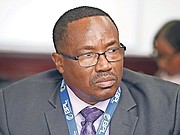Monday, August 19, 2019
By NATARIO McKENZIE
Tribune Business Reporter
nmckenzie@tribunemedia.net
BAHAMAS Power & Light’s (BPL) chairman has blamed the “genesis” of the utility’s present predicament on the first Christie administration’s decision to cut its base tariff rate.
Dr Donovan Moxey, pictured, told the Rotary Club of East Nassau: “The genesis of most of the issues BPL is faced with today has to do with not having enough revenue to operate. Back in 2003 a rate change was done without a rate study, without an understanding of the impact it would have on the organisation both in the short and long-term.”
He was referring to a decision by the late Bradley Roberts and the late Al Jarrett. The duo were minister for works, with responsibility for BEC, and the utility’s chairman, respectively, when the 2003 decision cut to BEC’s “base rate”, the portion of the customer tariff that covers its expenses, and generates its profits and cash flow, was taken.
Dr Moxey said that prior to the base rate cut, the then-Bahamas Electricity Corporation (BEC) was generating profits that “were consistent with what you would expect with a utility; somewhere between $10-20m a year”.
He added: “After that decision was made the company very quickly got into the hole. BEC has a debt that exceeds $200m. BPL has engaged another that exceeds $75m. We have a debt that we have to pay that exceeds over $346m. The debt service alone BPL has to come up with every month is $2m. That is just the interest payment.”
The base rate cut highlighted by Dr Moxey was said to have been a response to the hotel industry’s pressure for a reduction in energy costs to improve its competitiveness. But it left BEC selling electricity below cost, meaning that the state-owned monopoly was not earning sufficient income to cover all its non-fuel operational costs.
This ultimately plunged it into multi-million dollar losses from 2006 onwards , making it one of the world’s few loss-making monopolies. Faced with annual eight-figure losses, among the first items to go were regular maintenance of BEC’s generation fleet and investment in new, more efficient engines.
As a result, BEC was left with an aged, poorly-maintained and decaying generation capacity as well as a deteriorating transmission and distribution network by being starved of investment capital.
Michael Moss, appointed as BEC executive chairman by the last Ingraham administration, was able to claw back some of the base rate reduction and return the Corporation to “break even” with a $1,000 profit in 2011. However, his departure following the 2012 general election promptly plunged BEC back into “the red” with $20m losses.
Several reform efforts initiated under the Christie administration were never seen through to fruition, although PowerSecure was ultimately selected as BPL’s manager. This arrangement was overturned by the Minnis administration, which selected Shell North America as the preferred bidder to build, construct and operate a new power plant for New Providence.
However, the Shell selection left a three-year gap until the new power plant comes on stream, and it is this ‘hole’ that BPL has been unable to fill. It is unclear whether Dr Moxey’s historical explanation of BPL’s woes will cut much ice with Bahamians, who are likely to be more interested ion when load shedding will end and if they will ever have consistent, reliable power.
BPL’s chairman, meanwhile, said the utility spends $2m a month on rental generation and just 40 per cent of its customers pay their bills on time. “Our customers collectively owe us $123m,” he added, noting that BPL spends $30m a month with Shell North America for fuel.
“These are some of the fundamental problems that we have to fix, and will fix,” said Dr Moxey. “We have a great story to tell, and that’s a turnaround story. We will fix this. We have to just get past the bumps in the road.”
Dr Moxey also defended the Wärtsilä deal, adding: “We negotiated a very good deal with Wärtsilä , an extremely good deal with Wärtsilä. Wärtsilä understood strategically where we were going, and they understood the upside potential of building a strategic relationship with the national utility provider.”
Back in March, BPL announced the “fast track” of the $95m installation of 132 Mega Watts (MW) in new power generation. The state-owned utility confirmed it had contracted Wärtsilä to supply and install seven new engines in an unused section of its Clifton Pier power plant in a bid to reduce energy costs, eliminate load shedding and blackouts, and boost supply security by ultimately ending reliance on rental generation.
